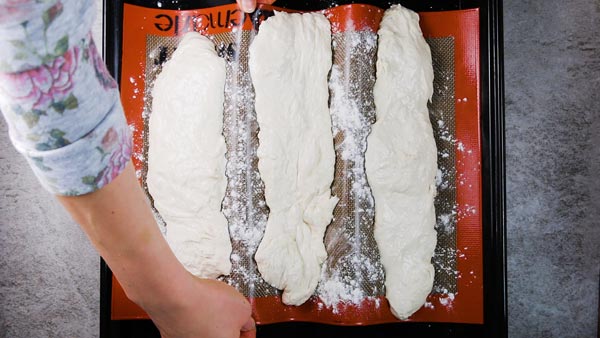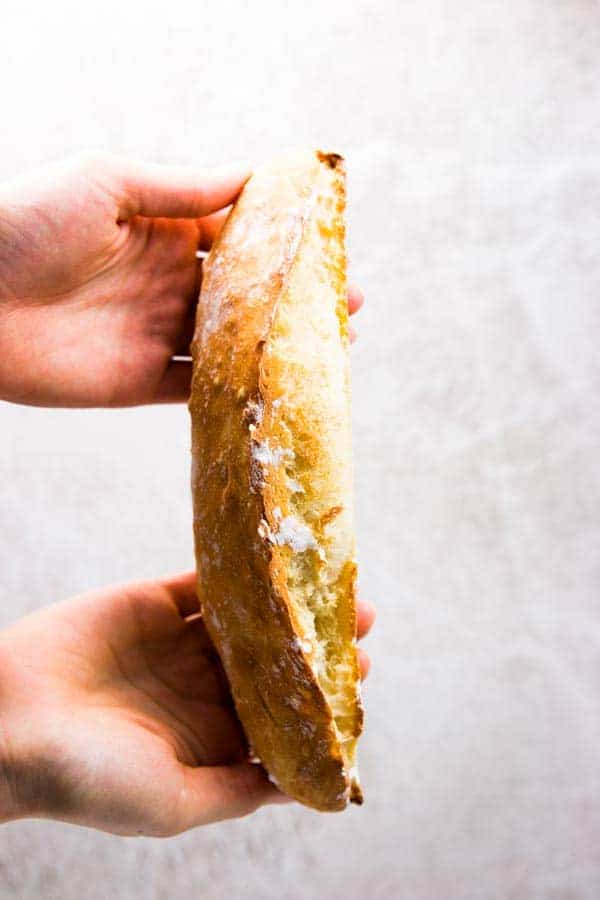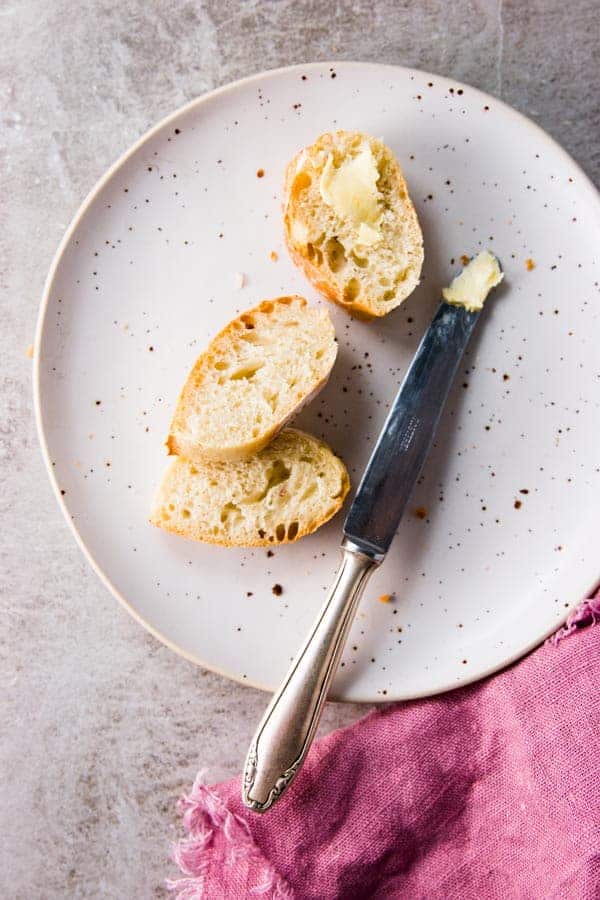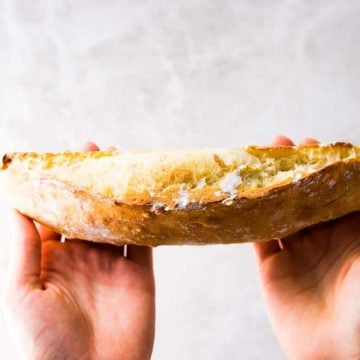Now you can make crusty, artisan-like no knead HOMEMADE French Bread from scratch with barely any effort! This is one of the best lazy cook’s/baker’s hack I’ve ever found – no kneading, no shaping, no overnight rise, and it comes out perfect every time with just 5 MINUTES PREP and about 10 minutes active time in total!
Can you tell how excited I am about this recipe?? I think the two exclamation marks in the title might have given it away already. This recipe is magical. Harry Potter level magic, I’m telling you.
The method used for it is… Not traditional. Definitely not authentic. And most likely something any artisan bakery owner in Paris would shout a flurry of French swear words at me for. Merde! Zut! Imbécile!
All you need to do for this magical homemade French bread is:
- Chuck water, yeast, a pinch of sugar, flour and salt into a bowl.
- Stir just until no dry flour remains.
- Cover and forget about it for two hours.
- Then all that’s left to do is cutting it in half or into thirds and baking it on high heat with a bowl of water in the oven for an extra crusty… Crust. (That was so eloquent.)
And the result is… As I said before: Magical. Extraordinary. So good you’ll want to stuff your face with the entire loaf right as it comes out of the oven.
The crust has a crunch to it, the interior is fluffy and chewy and has this nice, large, open crumb. Can you tell I’m obsessed?
I first heard about the Dutch oven no knead bread from a friend’s husband, about three years ago. I was suuuuper sceptic, because I believe in kneading yeast dough to develop the gluten. I mean, to be honest, I usually do bread quite differently. I activate the yeast. Then I make a sponge. I knead until the gluten has developed. I do multiple rises.
See my Challah Bread and Cinnamon Rolls for proof! And while they both turn out absolutely magnificent, I don’t even know what to believe anymore with all this no-knead business.
One major difference here is how slack the dough is with no-knead breads. You couldn’t knead it even if you tried, and the high moisture content is what gives the nice texture and crust.
And for the same reason (as with regular Dutch oven no-knead breads), this baguette magique can’t be slashed before baking, it just rips open randomly while in the oven. Which gives it that homey, artisan feel and makes the crack ultra-crispy.
I found this recipe on a German blog and I’ve been hooked every since. I made it three times last week alone ? Did you see my Insta-Story yesterday?? It’s just too good. We love it so much, my husband even ordered me a baguette pan as a surprise!
Now I will say, the bread does turn out with the best shape in a baguette pan, BUT I made it plenty times without one before!
It definitely needs something to hold it together though, so what I did before I had the special pan was to just use a Silpat mat, pulling it up between the baguettes to create long creases. Take a peak at the step photos below or scroll down to see it in the video – it’s easy peasy! And if you don’t have silicone baking mats, you can shape some aluminium foil and cover it with baking parchment!



I want to make my recipes as accessible to anyone and I’m usually very against over-purchasing single use objects for the kitchen, but if you’re planning on baking your own bread a lot and just happen to love a crusty French bread, I think the 15$ for an easy-to-store pan are justifiable ?
We have this for Sunday brunch. Or with a bowl of soup. Or topped with brie and prosciutto (hey, fusion cuisine!) for a quick lunch.
I initially tried this recipe just to prove it doesn’t work, but now I can’t stop making it – I hope you’ll try it too, let yourself be amazed by it and leave me a comment/star rating to let me know what you think about it!
– Nora xo
Watch how to make no knead homemade French bread:
Get the printable recipe:
Printable recipe
No Knead Homemade French Bread
Recipe details
Ingredients
- 1 ½ teaspoons active dry yeast
- 1 ¼ cups lukewarm water
- ½ teaspoon white sugar
- 3 cups all-purpose flour
- 1 teaspoon salt
Instructions
- Make the dough: Stir the yeast, water and sugar together in a large bowl. Stir in the flour and salt just until combined. Cover with a clean dish towel and allow to rest at room temperature for 2 hours.
- Cut the dough: Once the dough has risen, preheat the oven to 465°F. Place a rimmed cookie sheet on the lowest rack. Generously flour a work surface. Very carefully tip the dough on the worktop - try not to knock out any air. Cut the dough into three equal longish pieces (you can also do two for larger baguettes).
- Shape the bread: Carefully place the dough in a French bread pan. (Check the notes if you don't have a French bread pan - I made this without a French bread pan many times and this recipe works like a charm!)
- Bake: Fill the rimmed cookie sheet you placed in the oven earlier with water to create steam. Immediately put the bread on the middle rack and bake for 20-25 minutes (25-30 if making two larger baguettes), or until crusty on top. Turn the bread upside down and finish baking on the upper-middle rack for about 5 more minutes, or until the bottom is browned and crusty, too.










Savannah Spencer says
Can you freeze the bread? If so, how long?
Nora says
You can freeze the baked and cooled bread for 3 months. I highly recommend wrapping it well in plastic wrap, then place it in a freezer bag as well. Else it will suffer from freezer burn. To defrost, unwrap fully and place on a wire rack on the counter for several hours, until thawed. We love it lightly toasted. Hope this helps!
Anne says
How many packets of yeast are you using for 1 1/2 tsp?
Vicki says
This recipe is so awesome. Easy and delicious with simple ingredients. When we took the loaves out of the oven, the crunch in the bread was a dream come true. We had the butter waiting and it was an amazing experience. Lol. Just ordered the baguette baking tray because I definitely plan on making this bread again.
Nora says
I’m so glad, Vicki! And your description is making me want to bake bread ASAP ??
Kirsten says
I make this at least a few times a week. With an extra 0.5tsp yeast it’s ready to bake in an hour. I’ve also been experimenting with flavour and it’s delicious with black olives & no salt added or favourite so far is sundried tomatoes, olives and chive
Nora says
I’m so glad, Kirsten! And I love the idea of adding things, I absolutely have to try olives and sun-dried tomatoes! I might add some Feta cheese… Hmm, thanks for the idea!
Yoeung says
Hello,
I made your recipe exactly, only thing I did differently was made one large French loaf. It was the ugliest dough I’ve ever made and I wasn’t sure it’ll turn out well. It puffed in the oven and looked like a turtle shell (per my husband’s description). I wasn’t impressed AT ALL….. but then I cut it and it had very nice bubbles, great texture and tasted AMAZiNG! I couldn’t believe it was so easy to make, my kids loved it too (It was like sourdough but not sour). Thank you so much for sharing your recipe.
Nora says
Haha, I love the turtle shell description. Glad it tastes great though 😉
Bill Muto says
Have made this recipe and it’s always great. Wondering what you might suggest if we wanted to make pizza with it. Thanks, Bill, Tucson
Nora says
Bill, making pizza works so great with this dough! It’s what I pretty much always use. I have instructions for it here: https://www.savorynothings.com/easy-homemade-pizza-dough/
Hope this helps!
Christina Truter says
Lovely recipe I will definitely make it again! I added another half a cup of water though and my bread was not as airy as in the picture, so I still need to experiment some more.
Marion says
I’m still baking, and loving, this recipe. I’ve been experimenting with a brief second rise, while it’s in the pan, instead of putting it in immediately as you suggest. Fifteen minutes, maybe. Letting the oven get good and hot at the same time. Have you ever tried this? What are your thoughts?
all best to you and thanks!
Nora says
Marion, I have never tried a brief second rise but I will have to give it a go!
Criss says
So easy and so yummy! These baguettes do not last more than an hour in my house. Thank you, Nora!
marion says
One more question — I’ve been trying and comparing different no-knead recipes. I thing the folding step is kind of fun, and wonder what you think about folding this dough after the 2 hour rise but before shaping into loaves? Do you think it would help or hurt? I’m making the bread today… will check back in a bit. thanks
Nora says
Marion, no harm in folding the dough! It’s not necessary and I do it occasionally because the kids think it’s fun. If you enjoy it (I don’t, haha!) then please fold away!
Marion says
Yeah — I tried it, but I don’t think it made much difference either way. One tip I have that people could try is doing the two-hour rise in an oven set to 100 degrees. This has been working great for me with a wide variety of bread recipes. I also oiled the bread pan with olive oil, added a bit of crunch to the crust. Also — I accidentally left the de-panned loaves in the oven an extra 8-10 minutes, I thought they would be ruined but I think they might have been better!
marion says
Can you double it?
Nora Rusev says
Yes, absolutely, Marion!
Marion says
Making the bread yet again — double recipe as mentioned. I am wondering if letting it go longer than 2 hours is a good thing or a bad thing. Thoughts?
Nora says
Marion, I have been baking a lot of bread with as little yeast as possible lately and it works great. So if you need to let it sit for longer than 2 hours I recommend cutting back on the yeast. Eg if you’ll use half of the yeast the recipe calls for, you’ll need to give it around 4 hours to proof. Hope that helps!
Jane says
Great recipe, and couldn’t be easier!
DELICIOUS!
Jordan says
Made this today! So yummy and so easy! It has such a nice crispy crust.
JoAnn M OBrien says
Curious how the blobs on the silpat turn out to be nicely shaped and with a perfect incision in the first pic.
Nora Rusev says
JoAnn, thanks for sharing your concerns. Like I said in the post, the dough is too slack to slash, so it just randomly rips open during baking. The incision you thought you noticed in the picture is actually just the bread ripping open during baking. It’s one of the coolest parts of this recipe if you ask me – no need to be a pro at slashing bread.
As far as the transformation from blob to French bread goes: I don’t know how much bread you bake, but yeast produces carbon dioxide during fermentation, and this carbon dioxide expands in the heat of the oven before it sets. Every bread changes shape during baking; if it doesn’t, the recipe isn’t very good. Finally, the Maillard reaction helps to make the finished French bread look so good – this is the reaction that reduces sugar and amino acids in the heat of the oven, resulting in a nicely browned crust.
I hope this helps to alleviate some of your concerns about the recipe. Quite frankly, I find it a little insulting you would suggest I faked the photos – I take great pride in providing accurately tested recipes with transparency and integrity on this site. Have a nice day!
JoAnn M OBrien says
I do bake bread an awful lot with great success and understand the chemistry. I followed the recipe and the bread turned out okay. I have been a fan of Sally’s blog and her recipes for quite some time and her pics of the bread are closer to the actual result. No need to explain anything, thanks.
Lynn says
I’ve made this recipe many times – it’s a frequently requested addition to dinners! We really love it.
When mixing, my dough is nowhere near as wet as yours…I do aerate my flour etc. How much extra water can I safely add? Or decrease the flour a little? I am using canadian flour, as I’m in Canada – I have read it’s a little stronger than American flour?
We certainly enjoy the bread the way it comes together now, I’m just wondering if it can get any better than it is!
Nora says
Lynn, many factors can affect bread dough – from the exact flour you’re using to your altitude. If you want to try to get a wetter dough, I would just add more water tablespoon by tablespoon until you reach a consistency you’re looking for. And if it ends up too wet, work in some extra flour before shaping.
Allison says
Hi, just made 2 larger rather than 3 smaller loaves this morning and while tasty, my bread is quite dense. I used the silpat makeshift pan and did not stretch out the dough. I did add the recommended 5 minutes to the initial bake. My dough was not wet, just a little sticky when cutting with the bench scraper. Any thoughts? I’d sure like to get this incredibly fast and easy recipe right. Thank you 🙂
Nora Rusev says
Allison, I’m not 100% sure! One of my thoughts would be too much kneading, and my other thought underproofing and/or yeast that’s lost its power a little. Eg when I use organic dried yeast, I always have to proof for much longer because it’s less potent, else I get a more dense bread. Please let me know if you have any other questions!
Allison Burgett says
I tried the recipe again this time with an additional 1/4 cup of water thinking the lack of humidity where I live might be the issue and that solved the problem! I also made the dough the day before and proofed it overnight in the frig so I could have it for breakfast. It turned out wonderful! Soooo, if you live in the desert, you might want more water. I added the 1/4 cup 1 tablespoon at a time until my dough looked like the illustration. Thank you so much for this wonderful and very easy recipe .
Nora Rusev says
I’m so glad you figured this out, Allison! Thank you so much for sharing, I hope this will help other bread bakers who live in very dry climates – thanks again!
Kim says
Throwing this together for the first time and no mats or aluminum foil on hand. Can I use a loaf glass pan?? This is going with homemade cheddar broccoli soup tonight.
Nora Rusev says
Kim, did you see this: https://www.savorynothings.com/no-knead-bread-recipe/ you can bake it as a loaf in a Dutch oven. I’m sure a loaf pan would work as well, but if you’re going to bake it as one loaf the Dutch oven does give the best crust 🙂
Lily says
I admit I was a bit skeptical with such a short rise time, but it was such an easy recipe that I figured I’d try it out. I’m so glad I did because it was dee-lish!! Crusty on the outside, soft on the inside with a beautiful crumb. Tasty and easy recipe…what more can you ask for??! Thanks for posting!
Shelley says
So I’m making this right now…my initial stirred dough ball is extremely dry… is that normal? So excited to try!
Nora says
Hi Shelley, hm no, it shouldn’t be extremely dry. I just made this today and the dough is definitely not dry. It’s hard to describe the consistency – a little like slime to play with, haha! If you’re using cups to measure out the ingredients, it might be that you accidentally used too much flour, it happens to me all the time.
Irene says
WOW, wonderful crusty tasty treat…. a keeper for sure. I have tried other no-knead breads but were soft crust, this one is perfect to go with my balsamic vinegar and olive oil. Made 3 loaves and they disappeared faster than Merlin could accomplish!!!!!! Thanks a million.
Nora says
I’m so happy to read this, Irene! And yes, this bread disappears at lightning speed over here, too!
Phyllis says
I made this and FINALLY…a crusty, rustic, delicious French bread! I made it into two loaves using a Silpat. Perfect! ?
Nora says
So glad to hear this, Phyllis!
Michelle Collins says
Hello! I got a french baguette pan for Christmas and your recipe looks perfect. I have been making no knead breads for years and they all require bread flour but your recipe uses regular all purpose flour. Can I use bread flour in your recipe?
I’m going to make this bread tomorrow as it looks amazing and I’ve loved every no knead recipe I’ve tried so far!
Thanks so much!
Nora says
Hi Michelle, so sorry it took me this long to get back to you! I think it would be OK to use bread flour. I’ve made it with Tipo 00 before, and also with whole wheat. The amount of water might vary ever so slightly though. Did you end up trying it?
Lori says
I have been wanting to try to make a baguette for a long time but found traditional recipes rather daunting. So glad I found this and can’t wait to try it. I do have a couple of questions, though – can I replace the sugar with honey and, if so, how much? Also, the dough looks so sticky in the video – do you oil the bowl to help it slide out? Looking forward to your response, Thanks!
Nora says
Hi Lori, so glad you want to try this recipe – it’s a reader favorite. You can absolutely use a scant teaspoon of honey in place of the sugar. The dough is incredibly sticky. I never oil the bowl and just scrape it out with my hand. It’s a little messy at first, but when you get used to the recipe it takes no time at all. Hope that helps!
Marta Hernandez-Craven says
Hi, Nora…the bread looks yummy! I just have one question though…how did you get the pieces of dough from the worktop onto the silicone baking mat? Any tips/tricks would be appreciated. Thank you for sharing your recipe & I can’t wait to try it soon!!! Marta
Nora says
Hi Marta, I put a lot of flour on my worktop, so the dough doesn’t stick. And then I just lift up the dough pieces by holding them on both ends. They stretch out into a long-ish shape that way, which is perfect for the French bred shape 🙂 Hope that helps, and I hope you’ll enjoy the bread!
Linda J says
This bread was delicious! And super easy to make! I’m going to try it with my sourdough starter next. Thanks for the recipe!
Nora says
So glad you liked the bread, Linda! And do let me know how your sourdough version turns out – I’m curious!
Prema Hoffman says
Such a simple , delicious recipe . Thank you for sharing it .
Nora says
Prema, I’m so glad you enjoyed the homemade French bread. It’s really so simple, sometimes these turn out to be the best recipes! – Nora x